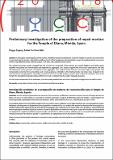Por favor, use este identificador para citar o enlazar a este item:
http://hdl.handle.net/10261/185232COMPARTIR / EXPORTAR:
 SHARE
BASE SHARE
BASE
|
|
| Visualizar otros formatos: MARC | Dublin Core | RDF | ORE | MODS | METS | DIDL | DATACITE | |

| Título: | Preliminary investigation of the preparation of repair mortars for the Temple of Diana, Mérida, Spain |
Otros títulos: | Investigación preliminar de la preparación de morteros de reconstrucción para el Templo de Diana, Mérida, España | Autor: | Ergenç, D. CSIC ORCID; Fort González, Rafael CSIC ORCID | Palabras clave: | Conservation Roman mortar Microstructural and thermal analyses Conservación Mortero romano Análisis microestructrales y análisis termales |
Fecha de publicación: | 25-jun-2017 | Editor: | International Institute for Conservation of Historic and Artistic Works. Grupo Español | Citación: | Ge-conservación 1(11): 42-49 (2017) | Resumen: | [EN] In this paper, characterization of the mortars of different constructive elements in Roman Temple of Diana for its conservation is presented. Mortar samples collected from different parts of the Temple were characterized by means of polarized optical microscopy (POM), X-ray diffraction (XRD), thermal analysis (TGA-DSC) and X-ray fluorescence (XRF). The optical microscopy results revealed that the mortars are composed of lime binder and quartz, feldspar and biotite grains together with granitic and metamorphic rock fragments as aggregates. XRD analysis supports the microscopic observations and adds the information of the presence of actinolite in the aggregates. XRD analysis further indicates the same origin of the granitic and metamorphic rocks from the surroundings and reveals an absence of biotite in the flooring mortar and only a trace of quartz in the masonry mortar of criptoporticus. According to results of TGA-DSC and XRF analyses, mortars were used in the channel in front of the Temple, the foundation of granite ashlar, and the inner wall of criptoporticus has higher hydraulic character. For the future conservation of the monument, the information provided here about the composition of original mortars will be useful. [ES] En este trabajo se presenta la caracterización de los morteros de diferentes elementos constructivos en el Templo Romano de Diana con vista a su conservación. Las muestras de mortero que fueron recogidas de diferentes partes del Templo se caracterizaron por microscopía óptica polarizada (POM), difracción de rayos X (DRX), análisis térmico (ATG-DSC) y fluorescencia de rayos X (FRX).Los resultados de la microscopía óptica revelaron que los morteros fueron realizados con un aglomerante de cal, y con agregados de cuarzo, feldespato y biotita junto con fragmentos de rocas graníticos y metamórficos. Los análisis DRX apoyan las observaciones microscópicas y añaden la información de presencias de actinolita en los agregados que indican el mismo origen de las rocas graníticas y metamórficas del entorno geológico de Mérida (España) y muestra la ausencia de biotita en el mortero de suelo y poco cuarzo en el mortero de mampostería de criptoporticus. Según los resultados proporcionados con ATG-DSC y FRX los morteros utilizados para la construción del canal frente al Templo, la fundación de sillería de granito y la pared interna de criptoporticus tienen alto carácter hidráulico. Para la conservación futura del monumento es necesario tener presente estas características para el diseño de los morteros de restauración a utilizar. |
Descripción: | Special Issue YOCOCU 2016 (V Conferencia Internacional YOCOCU 2016). | Versión del editor: | https://ge-iic.com/ojs/index.php/revista/article/view/443 | URI: | http://hdl.handle.net/10261/185232 | ISSN: | 1989-8568 |
| Aparece en las colecciones: | (IGEO) Artículos |
Ficheros en este ítem:
| Fichero | Descripción | Tamaño | Formato | |
|---|---|---|---|---|
| Preliminary investigation_Ergenç.pdf | 2,56 MB | Adobe PDF |  Visualizar/Abrir |
CORE Recommender
Page view(s)
175
checked on 18-abr-2024
Download(s)
100
checked on 18-abr-2024
Google ScholarTM
Check
NOTA: Los ítems de Digital.CSIC están protegidos por copyright, con todos los derechos reservados, a menos que se indique lo contrario.
